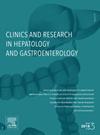Lack of prior screening for advanced liver fibrosis in patients with newly diagnosed hepatocellular carcinoma: Results from a prospective multicentre study
IF 2.4
4区 医学
Q2 GASTROENTEROLOGY & HEPATOLOGY
Clinics and research in hepatology and gastroenterology
Pub Date : 2025-04-30
DOI:10.1016/j.clinre.2025.102607
引用次数: 0
Abstract
Introduction
Hepatocellular carcinoma (HCC) most commonly occurs in a cirrhotic liver. In France, a screening rate of 20 % to 35 % has been reported in clinical cohorts. In these studies, patients were generally enrolled in centers of the same category (university or general hospitals). The aim of this study was to prospectively investigate the circumstances of HCC diagnosis and the causes of HCC screening failure in a cohort of patients from a regional network.
Methods
This prospective multicenter study enrolled patients with newly diagnosed HCC from October 2022 to July 2024. Investigators were from one university hospital, two private clinics, and three general hospitals.
Results
Two hundred patients were included. Diagnosis was made by screening in 31.0 % of cases. Most patients had comorbidities that could lead to screening for liver fibrosis: current or past history of alcohol consumption (74.6 %), diabetes (51.4 %), hypertension (75.7 %), dyslipidemia (47.4 %). The FIB-4 score was ≥ 2.67 in 74.5 % of patients in the “in screening” group and 63.9 % in the “not in -screening” group. Among the 138 patient in the ”not in screening” group, 115 (83.3 %), 34 (24.6), 23 (16.7 %) and 13 (9.4 %) declared they had visited a general practionner, a cardiologist, a gastroenterologist, and/or an endocrinologist within the 12 months prior to HCC diagnosis, respectively.
Conclusion
Recognition by general practitioners of patients at risk of chronic liver disease and identification of advanced fibrosis are major areas for optimization of HCC screening.
新诊断的肝细胞癌患者缺乏预先筛查晚期肝纤维化:来自一项前瞻性多中心研究的结果
肝细胞癌(HCC)最常见于肝硬化。在法国,据报道临床队列的筛查率为20%至35%。在这些研究中,患者通常被纳入同一类别的中心(大学或综合医院)。本研究的目的是前瞻性地调查来自区域网络的一组患者的HCC诊断情况和HCC筛查失败的原因。该前瞻性多中心研究纳入了2022年10月至2024年7月期间新诊断的HCC患者。调查人员来自一所大学医院、两家私人诊所和三家综合医院。结果纳入200例患者。31.0%的病例通过筛查确诊。大多数患者有可能导致肝纤维化筛查的合并症:当前或既往饮酒史(74.6%)、糖尿病(51.4%)、高血压(75.7%)、血脂异常(47.4%)。筛查组74.5%的患者FIB-4评分≥2.67,未筛查组63.9%的患者FIB-4评分≥2.67。在“未筛查”组的138名患者中,分别有115名(83.3%)、34名(24.6%)、23名(16.7%)和13名(9.4%)表示在HCC诊断前的12个月内曾看过全科医生、心脏病专家、胃肠科医生和/或内分泌科医生。结论全科医生对慢性肝病高危患者的认识和晚期纤维化的识别是优化HCC筛查的主要方面。
本文章由计算机程序翻译,如有差异,请以英文原文为准。
求助全文
约1分钟内获得全文
求助全文
来源期刊

Clinics and research in hepatology and gastroenterology
GASTROENTEROLOGY & HEPATOLOGY-
CiteScore
4.30
自引率
3.70%
发文量
198
审稿时长
42 days
期刊介绍:
Clinics and Research in Hepatology and Gastroenterology publishes high-quality original research papers in the field of hepatology and gastroenterology. The editors put the accent on rapid communication of new research and clinical developments and so called "hot topic" issues. Following a clear Editorial line, besides original articles and case reports, each issue features editorials, commentaries and reviews. The journal encourages research and discussion between all those involved in the specialty on an international level. All articles are peer reviewed by international experts, the articles in press are online and indexed in the international databases (Current Contents, Pubmed, Scopus, Science Direct).
Clinics and Research in Hepatology and Gastroenterology is a subscription journal (with optional open access), which allows you to publish your research without any cost to you (unless you proactively chose the open access option). Your article will be available to all researchers around the globe whose institution has a subscription to the journal.
 求助内容:
求助内容: 应助结果提醒方式:
应助结果提醒方式:


